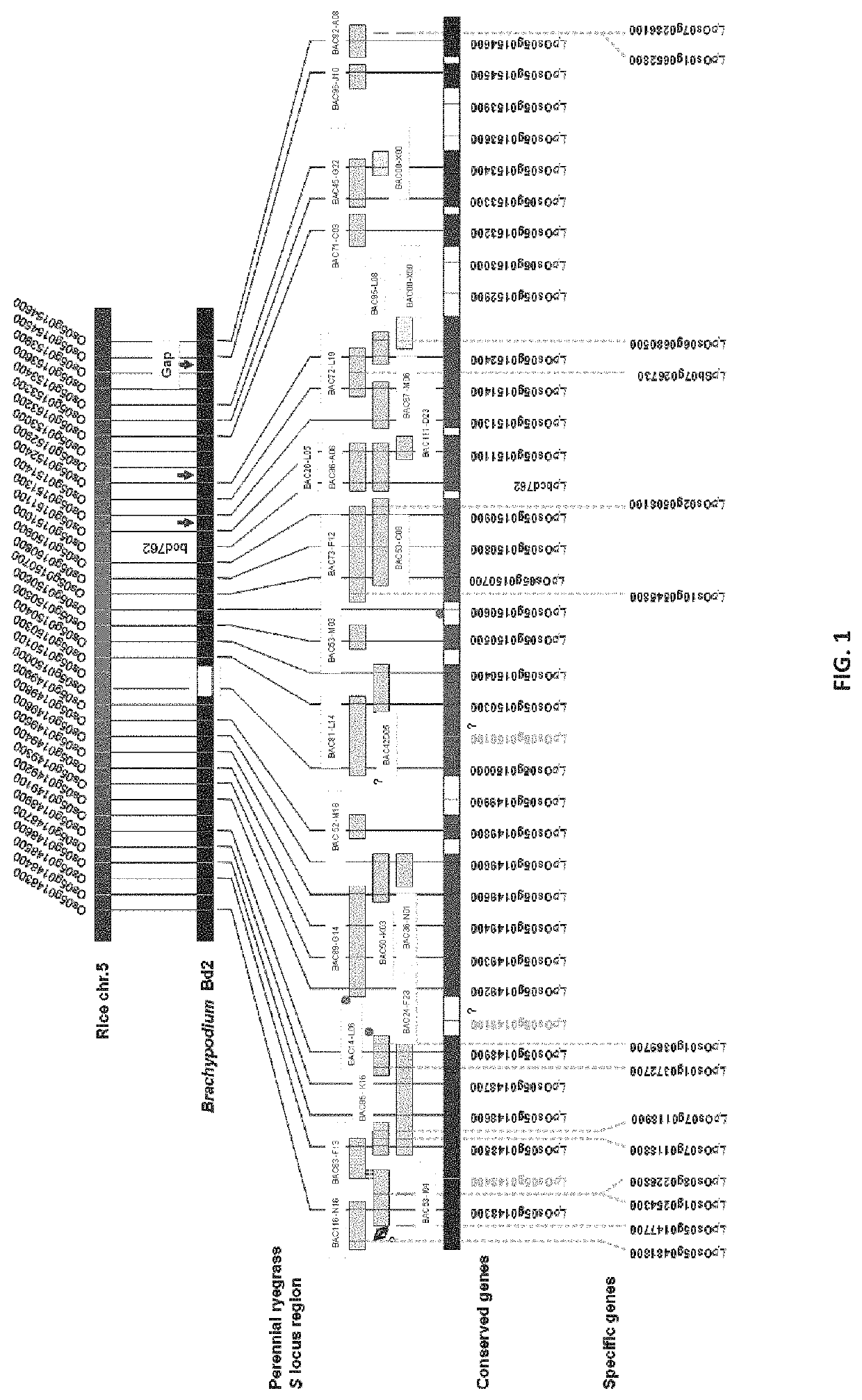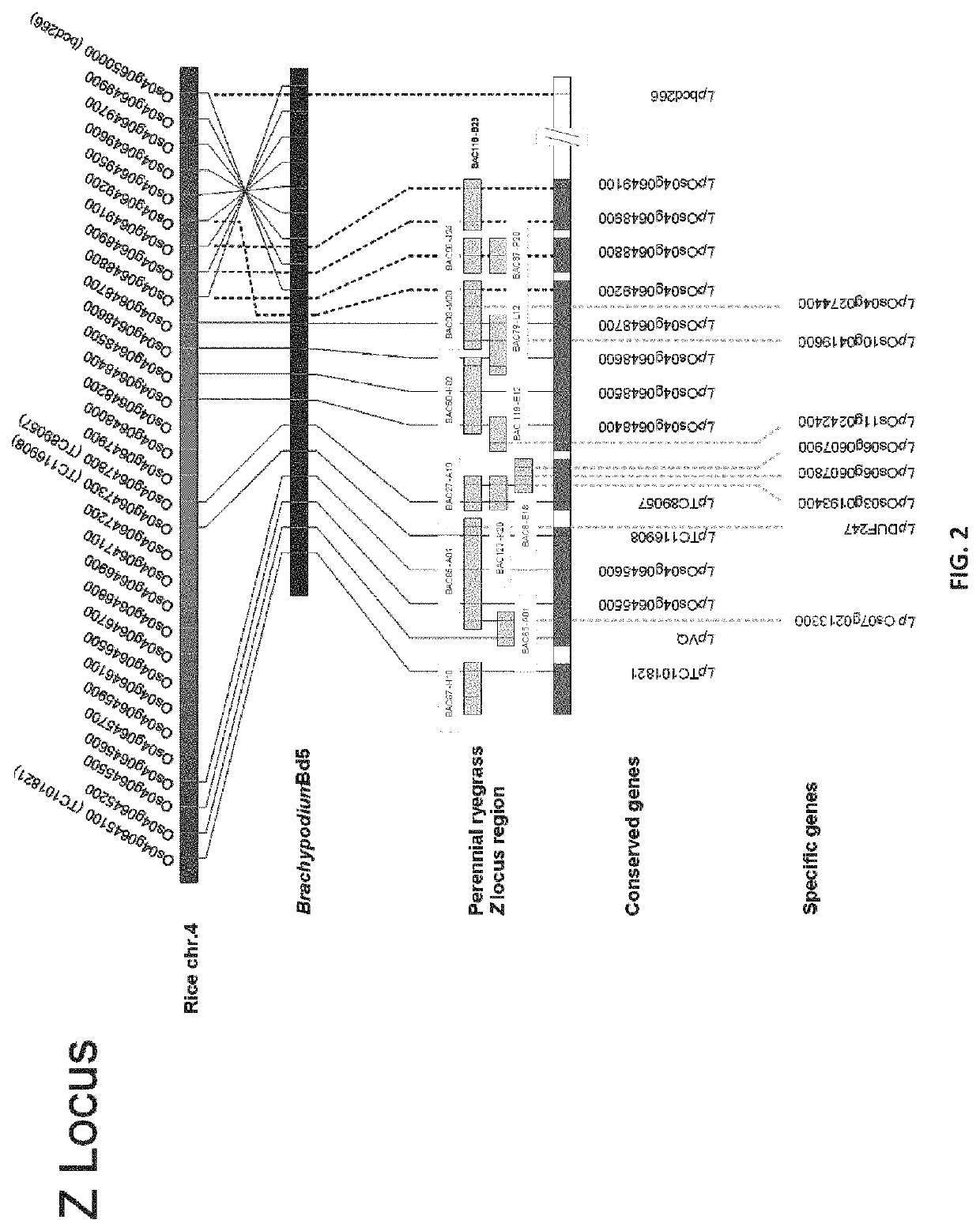Manipulation of self-incompatibility in plants
a technology of plant hybridization and self-incompatibility, which is applied in the direction of peptide sources, bio chemistry apparatus and processes, etc., can solve problems such as interference with the energy status of cells, and achieve the effect of facilitating immunological screening of cdna expression libraries
- Summary
- Abstract
- Description
- Claims
- Application Information
AI Technical Summary
Benefits of technology
Problems solved by technology
Method used
Image
Examples
example 1
of SI Genes
[0301]Both the S and Z locus was delimited through comparative genomics and BAC clone and genomic sequencing. All genes within the sequence data were identified (Tables 1 and 2). Sequences were determined through the FGENESH prediction software. Expression profiles were determined for each gene as described in Example 6. Expression profiles were determined through BLAST analysis of sequence reads from multiple tissues of the Lolium perenne L. genotype Impact04, compared to the Brachypodium distachion CDS gene sequences used as orthologous templates (See FIGS. 88-108).
[0302]
TABLE 1Genes identified within the S locusNucleicacidPolypeptideRyegrass geneSEQ IDSEQ IDidentifiedSynPredicted Gene FunctionNO:NO:LpOs05g0481800Protein prenyltransferase domain171containing protein,pentatricopeptide repeat-containing proteinLpOs05g0147700Cyclin-like F-box domain272containing proteinLpOs05g0148300Ribosomal protein S27,373mitochondrial family proteinLpOs01g0254300Similar to Pectinesteras...
example 2
ing Data Identified DNA Nucleotide Variance
[0304]A cohort of 21 genes were selected as key candidates of the S and Z loci. The genes were selected based on expression profile as well as sequence annotation.
[0305]The collection of 21 genes all had PCR primers designed to resequence the coding regions of the genes. The designed PCR amplicons were optimised to generate large genomic fragments. A total of 50 plant genotypes were used as the template DNA for resequencing. The 50 plants were chosen as a diverse spread of plants with a potential wide range of diversity to maximise allelic variation at the genic loci being resequenced.
[0306]The amplicons were generated, then pooled from each genotype and physically sheared to smaller fragments. DNA bar codes and sequencing adaptors were ligated onto the sheared fragments to identify each sample and then all samples were combined and sequenced using a next-generation Illumina MiSeq platform with 300 bp×2 reads.
[0307]The resulting sequence da...
example 3
of SI Genes: Cloning of the Ryegrass LpOs06g0607800 26S Proteasome Gene
[0312]In order to develop novel genetic markers for fine-scale genetic and physical mapping of the perennial ryegrass SI loci, linked heterologous cDNA-derived RFLP markers were selected for the S locus and Z on the basis of ortholocus co-segregation in cereal rye and / or blue canary grass. Molecular marker development, genetic mapping and region dissection is described in Shinozuka et al (2010). As a result of the assembled data sets fine-scale comparative sequence synteny with the model Poaceae species, specifically Oryza sativa and Brachypodium distachyon, was achieved for the delimited S and Z regions. Using the defined gene complement from the model Poaceae species, a BAC library was screened with primer pairs specific to the genes described and 39 specific clones were identified. The identity of the selected BAC clones was verified through direct sequencing of locus-specific amplicons. The specific BAC clone...
PUM
 Login to View More
Login to View More Abstract
Description
Claims
Application Information
 Login to View More
Login to View More - R&D
- Intellectual Property
- Life Sciences
- Materials
- Tech Scout
- Unparalleled Data Quality
- Higher Quality Content
- 60% Fewer Hallucinations
Browse by: Latest US Patents, China's latest patents, Technical Efficacy Thesaurus, Application Domain, Technology Topic, Popular Technical Reports.
© 2025 PatSnap. All rights reserved.Legal|Privacy policy|Modern Slavery Act Transparency Statement|Sitemap|About US| Contact US: help@patsnap.com



